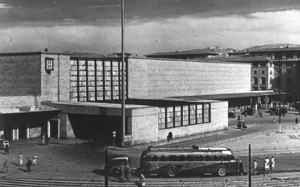The Station
The station averages about 160,000 daily transits, totaling 59 million visitors annually.
It represents a typical example of a "terminal" station, located in the heart of the city and serving as the focal point of the Florence public transport system, a characteristic enhanced by the small size of the city center.
The station accommodates over 400 trains per day and is a key interchange point for numerous bus and taxi routes.
History

In the context of Italian stations, Florence Santa Maria Novella stands out as one of the most architecturally significant recent buildings. The first station in Florence, “Leopolda”, was built in 1844 based on a design by Robert Stephenson, the son of the inventor of the railway, and was one of the first stations in Italy, located outside the city walls.
Four years later, the second station, “Maria Antonia”, was constructed within the city walls, representing a significant innovation for its time. The “Maria Antonia” station was demolished to make way for the current station, which, overlooking the Church of Santa Maria Novella, is a masterpiece of rationalism and one of the highest expressions of the modern movement in Italian architecture.
After an agreement was reached between the municipality and the Italian Railways to keep the Florence station within the city walls, a national competition for the new passenger building was announced in 1932. The competition was won by the Toscano Group, led by architect Giovanni Michelucci and composed of Baroni, Berardi, Gamberini, Guarnieri, and Lusanna.
The station was inaugurated in 1935: its main features are a large hall covered by a glass and steel surface and a terminal gallery that, in its functions, anticipates the one later built in Rome. The exterior cladding reflects the materials and colors of the city, while inside there are valuable works such as sculptures by Italo Griselli and paintings by Ottone Rosai and Mario Romoli.
Redevelopment

Over nearly eighty years of history, the new Florence Santa Maria Novella station has seen the construction of numerous boxes and various expansions, which, accumulating over time, had significantly altered the architectural perception of the spaces. For this reason, the redevelopment carried out by Grandi Stazioni primarily focused on restoring and enhancing the historical spaces and finishes by removing all the superfluous additions made over the years.
This intervention did not significantly alter the spaces. However, by eliminating all the extrusions that hindered the proper readability of the spaces, the station immediately regained the grandeur originally conceived by Michelucci, and the numerous finely crafted architectural details that embellish the environments were once again valued.
The station, which after the cleaning and recovery work had regained its aesthetic and architectural values, also required an improvement of the internal pathways due to the increased traffic that, over the years, had affected the Florence transport hub. As a result, internal routes were enhanced through the reuse of underground spaces, the creation of new service areas, and a new staircase connecting the platform level with the underground level, the parking lot, and the station exits.
As part of the enhancement of intermodal services, the Piazza Adua area was also redeveloped, with the creation of a new parking lot capable of accommodating up to 35 car spaces and 82 motorcycle spaces.
Lay-out
The station is structured in several buildings and multiple levels:
The underground level, which hosts services and commercial activities, connects the station with the parking area and station exits, as well as housing the underground pedestrian passages under the tracks.
The ground floor, home to the tracks, dedicated to passenger services and commercial activities.
The mezzanine floor, which houses a restaurant and some FS offices.
The upper floors, dedicated to accommodations and FS offices.
Security
At Florence Santa Maria Novella station, a control room is operational, ensuring continuous monitoring of the station through surveillance services and supervision of security systems.
Additionally, there is a security service that ensures the coverage of areas, detection, and reporting of non-compliance, as well as security interventions. Furthermore, it is responsible for managing emergencies, in collaboration with maintenance personnel, providing first response and support to external emergency responders.
To support and optimize human resources, security systems are also integrated. Specifically, the station is equipped with:
Video surveillance and digital video recording systems;
Access control and anti-intrusion systems;
Fire detection systems.
The system, as described, is organized in close coordination with the Railway Police to ensure the immediate escalation and management of any ongoing critical situations.
Station services
- Arrival and departures
- Ticket offices
- Casa Italo
- Luggage store
- Pharmacy
- Information and Assistance
- Turist information
- Parking
- Railway Police
- Sala Blu - Assistance
- Freccia Club room
- Banking and insurance services
- Restrooms
- Shopping